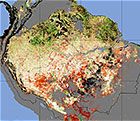The dry season in the southern part of the Amazon rainforest is lasting three weeks longer than it did 30 years ago, putting the forest at higher risk for fires and tree mortality, according to new research from the University of Texas. The most likely culprit is global
warming, says lead researcher Rong Fu. Even if future wet seasons become wetter, rainforest soil can only hold so much water, Fu explained. That water must sustain the forest throughout the entire dry season, and as the dry season lengthens the rainforest becomes increasingly stressed, vegetation growth slows, and the risk of fire rises. During a severe drought in 2005, the Amazon actually released a large amount of carbon dioxide into the atmosphere, rather than acting as a net carbon sink. Should dry seasons continue to expand, conditions like those in 2005 could become the norm, accelerating the buildup of CO2 in the atmosphere, the researchers wrote in the Proceedings of the National Academy of Sciences.
Click to Enlarge
Myneni/Bi/NASA
Amazon vegetation index